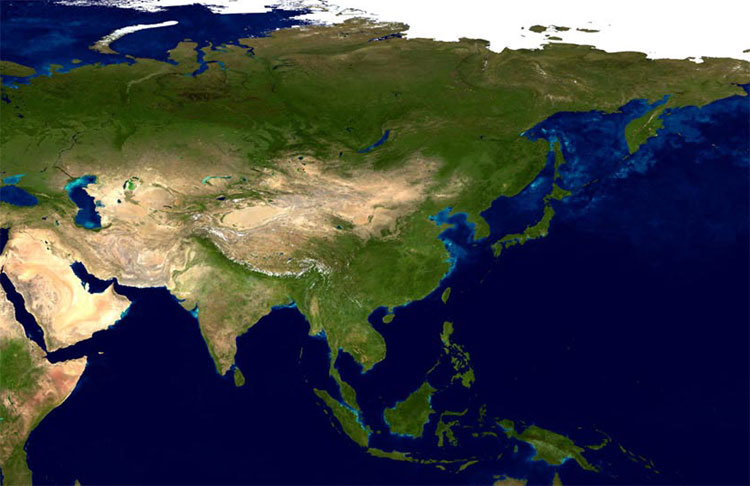Asia-Pacific just finalized the largest free-trade deal ever signed. 15 countries are now part of a massive economic zone representing 30% of the worldwide total GDP. It marks the acceleration of intra-region trade, reducing customs barriers for products manufactured regionally.
As we can observe below, Asian region is resisting much more than the others to the Covid-19 pandemic. Growth forecast for 2021 and after seems to be massive, comparing to other regions.
It will have a huge impact on imports for products not manufactured regionally and will create a tough competition for industries who are not present into this new trade zone. This situation is an opportunity and has to motivate our leaders tostrengthen our business and political relationships with them, instead of permanently marking their lack of governance.
I use to travel every month across the region, even during this pandemic, and I can witness that too many countries are so active and are developing successes with locals. For example, we can read that US government has signed on May 2020 abilateral agreement for the concern of pharmaceuticals, Biotechs.
Indonesian government recently voted its “omnibus law” which gives lots of benefit for foreign investors/operators.
Regionally, all countries have a large industrial footprint, with lots of family owned groups. Most of them are now looking to “premiumise” their production / construction due to the emergence of the middle class. They must, and they are looking todo so, team-up with foreign companies offering cutting- edge technologies and know-how.
We, as French entrepreneurs, have to accelerate our actions and developments in the region. Large companies like Danone, Suez, Vinci, Thales (and others) are already active, but it is not enough. For taking the benefit of this “new Asian tradedeal”, we have to be locally deployed. Just have a look at the benchmark of GDP growth. It speaks for itself.
Pierre-Marie Relecom
Numbers 2020 and before: Source IMF
Forecast 2021 and after: Source local governments communicated to IMF
| YoY % | 2019 | 2020 | 2021 | 2022 | 2023 | 2024 | 2025 |
| World | 2,8 | -4,4 | 5,2 | 4,2 | 3,8 | 3,6 | 3,5 |
| South Asia | 4,3 | -8,4 | 8,1 | 7,5 | 7,2 | 7,1 | 6,9 |
| Southeast Asia | 4,7 | -3,3 | 6,1 | 5,5 | 5,4 | 5,3 | 5,2 |
| East Asia | 4,7 | 0,3 | 6,7 | 4,9 | 4,8 | 4,7 | 4,5 |
| European Union | 1,7 | -7,6 | 5 | 3,3 | 2,5 | 2 | 1,6 |
| Latin America | 0 | -8,1 | 3,6 | 2,7 | 2,7 | 2,5 | 2,5 |
| ECOWAS | 4,9 | -1,3 | 4,4 | 5,7 | 6,3 | 5,6 | 5,4 |
| NAFTA | 1,2 | -6,8 | 3,9 | 2,9 | 2,3 | 1,9 | 1,9 |
| Middle East | -0,4 | -6,6 | 2,6 | 3,1 | 2,8 | 2,4 | 2,4 |
East Asia
| YoY % | 2019 | 2020 | 2021 | 2022 | 2023 | 2024 | 2025 |
| East Asia | 4,7 | 0,3 | 6,7 | 4,9 | 4,8 | 4,7 | 4,5 |
| China, People’s Republic of | 6,1 | 1,9 | 8,2 | 5,8 | 5,7 | 5,6 | 5,5 |
| Korea, Republic of | 2 | -1,9 | 2,9 | 3,1 | 2,9 | 2,6 | 2,4 |
| Mongolia | 5,1 | -2 | 6 | 5,5 | 5 | 5 | 4,5 |
| Taiwan Province of China | 2,7 | 0 | 3,2 | 2,1 | 2,1 | 2,1 | 2,1 |
| Japan | 0,7 | -5,3 | 2,3 | 1,7 | 1,2 | 1 | 0,6 |
| YoY % | 2019 | 2020 | 2021 | 2022 | 2023 | 2024 | 2025 |
| Southeast Asia | 4,7 | -3,3 | 6,1 | 5,5 | 5,4 | 5,3 | 5,2 |
| Brunei Darussalam | 3,9 | 0,1 | 3,2 | 3,7 | 2,3 | 2 | 1,8 |
| Cambodia | 7 | -2,8 | 6,8 | 7,3 | 7,4 | 7,4 | 6,9 |
| Indonesia | 5 | -1,5 | 6,1 | 5,3 | 5,2 | 5,1 | 5,1 |
| Lao P.D.R. | 5,2 | 0,2 | 4,8 | 5,6 | 5,8 | 5,8 | 6,1 |
| Malaysia | 4,3 | -6 | 7,8 | 6 | 5,7 | 5,3 | 5 |
| Myanmar | 6,5 | 2 | 5,7 | 6,2 | 6,4 | 6,5 | 6,5 |
| Philippines | 6 | -8,3 | 7,4 | 6,4 | 6,5 | 6,5 | 6,5 |
| Singapore | 0,7 | -6 | 5 | 2,6 | 2,6 | 2,5 | 2,5 |
| Thailand | 2,4 | -7,1 | 4 | 4,4 | 4,3 | 4,3 | 3,7 |
| Timor-Leste | 3,1 | -6,8 | 4 | 4,8 | 2,4 | 2,6 | 2,6 |
| Vietnam | 7 | 1,6 | 6,7 | 7,4 | 7,2 | 6,9 | 6,6 |
| Southeast Asia | 4,7 | -3,3 | 6,1 | 5,5 | 5,4 | 5,3 | 5,2 |
| Source IMF | |||||||
| YoY % | 2019 | 2020 | 2021 | 2022 | 2023 | 2024 | 2025 |
| European Union | 1,7 | -7,6 | 5 | 3,3 | 2,5 | 2 | 1,6 |
| Austria | 1,6 | -6,7 | 4,6 | 2,1 | 1,9 | 1,7 | 1,6 |
| Belgium | 1,4 | -8,3 | 5,4 | 2,7 | 2,2 | 1,7 | 1,3 |
| France | 1,5 | -9,8 | 6 ??? | 2,9 | 2,3 | 1,9 | 1,7 |
| Germany | 0,6 | -6 | 4,2 | 3,1 | 1,8 | 1,3 | 1,2 |
| Greece | 1,9 | -9,5 | 4,1 | 5,6 | 3,7 | 2,4 | 1 |
| Ireland | 5,9 | -3 | 4,9 | 4,3 | 3,5 | 2,8 | 2,6 |
| Italy | 0,3 | -10,6 | 5,2 | 2,6 | 1,7 | 0,9 | 0,9 |
| Netherlands | 1,7 | -5,4 | 4 | 2 | 1,7 | 1,5 | 1,5 |
| Poland | 4,1 | -3,6 | 4,6 | 4,5 | 3,7 | 2,9 | 2,4 |
| Portugal | 2,2 | -10 | 6,5 | 4,8 | 2,9 | 2 | 1,7 |
| Spain | 2 | -12,8 | 7,2 | 4,5 | 3,4 | 2,8 | 1,5 |
| Sweden | 1,3 | -4,7 | 3,5 | 2,9 | 2,4 | 2,1 | 2 |
| Source IMF | |||||||
The European Union has been greatly affected by the covid pandemic. Most of EU countries implemented lockdown for months slowing down economy. Local governments set up new schemes to maintain their economy and preserve employment. On the European and national level, € 4,2 trillion of economic response has been taken (loan with sovereign guarantee, subsidiaries, funding for short-time work scheme…). Despite all those measures, the European Union is by far one of the most affected regions in the world with an average GDP decrease of -7,6%. As the date of October 21st, 2020 many European countries (France, Germany, Spain, Italy…) strengthen their restrictions over the pandemic. Therefore, it is expected that the 2021 GDP growth projection will be revised soon with the second wave.
To conclude, the GDP of almost all countries will decrease in 2020, according the IMF forecast. Whereas Western countries are carrying and leading the global economy, there are the most impacted countries by the pandemic. Naturally, we observedgeneral decrease of GDP in 2020 and international trade should still be at a very low rate for the year. Moreover, it is important to qualify the data for 2021 as there are not updated yet. In the case the pandemic continue to spread in 2021, it is highly probable that the IMF revised the GDP forecast for 2021.



